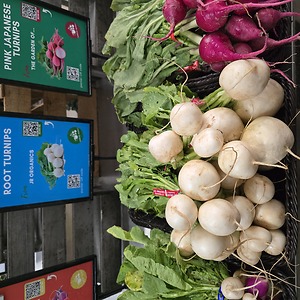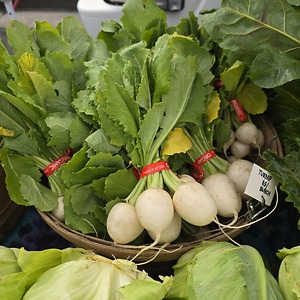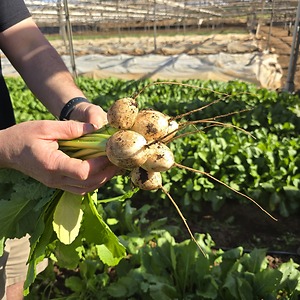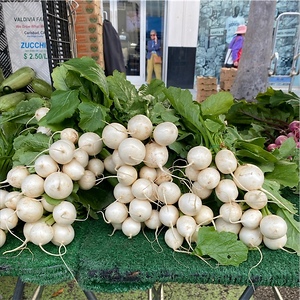


Baby Bunch Turnips
Estimated Inventory, 24 ct : 6.00
This item was last sold on : 07/10/25
Description/Taste
Baby Turnips are small in size, averaging 2 to 5 centimeters in diameter, and have a round to oval appearance with one prominent, thin, and tapered taproot. The bulbous roots are connected to thin, upright, and slender stems with broad, frilled, and textured leaves. The roots are smooth, taut, and firm with thin skin, and depending on the variety, they can appear in white, cream, ivory, bi-colored, pink, or purple hues. Underneath the surface, the flesh is solid, dense, tender, and aqueous with a crisp, crunchy, and succulent consistency. The flesh also varies from white and ivory to pale-colored hues. The stems and leaves showcase shades of green and are crisp and subtly chewy. The roots, leaves, and stems of Baby Turnips are edible raw and cooked. The roots have a mild, sweet, and delicate taste, while the greens have a vegetal and subtly peppery flavor.
Seasons/Availability
Baby Turnips are available year-round, with a peak season in the fall through early summer.
Current Facts
Baby Turnips, botanically classified as Brassica rapa, are a category of several varieties belonging to the Brassicaceae family. The small root vegetables are favored for their delicate flavor and ability to be consumed raw or cooked. The term Baby Turnip generally encompasses turnips harvested early in their season and varieties that are small in size at maturity. The most common type of Baby Turnips sold in commercial markets are the cultivars specifically developed to be small with thin skin and a milder, sweeter flavor. Japanese turnips, also known as Tokyo turnips and Harukei, are popular Baby Turnips. Other specialty types of Baby Turnips are mainly grown in home gardens, such as Baby Pink turnips, Sweet Bell, and Pastel Duo. Baby Turnips are sometimes called Salad turnips in markets and are fast-growing, maturing 30 to 45 days after harvest. The roots, stems, and leaves are edible and are utilized by chefs and home cooks worldwide for their versatility and ability to be incorporated into savory fresh or cooked preparations.
Nutritional Value
Baby Turnips are a source of vitamins C and E to strengthen the immune system while guarding the cells against the damage caused by free radicals. Turnips also provide fiber to regulate the digestive tract, calcium and phosphorus to support bones and teeth, potassium to balance fluid levels within the body, and iron to develop the protein hemoglobin for oxygen transport through the bloodstream. In natural medicines practiced throughout Europe, turnips were once consumed to promote digestion and are thought to carry anti-inflammatory properties. The roots also contain some magnesium to control nerve functions, copper to produce red blood cells, manganese to assist the body in producing energy, and other nutrients, including zinc, thiamin, riboflavin, niacin, and folate. Turnips greens are a source of vitamins A, C, K, and folate to maintain healthy organs and cell growth. The greens also provide antioxidants to reduce inflammation and improve the body's overall health.
Applications
Baby Turnips have a mild, sweet, and subtly peppery flavor suited for fresh and cooked preparations. The small root vegetables should be washed before consumption and have thin, unnoticeable skin that does not need to be removed. Baby Turnips are favored raw and can be eaten whole like an apple, sliced and served with salt and butter, or cut as a crudité. The roots can also be eaten with dips like guacamole, yogurt, and hummus, shredded into slaws, or sliced and layered into sandwiches. In addition to fresh preparations, Baby Turnips can be cooked and are often braised, grilled, sauteed, or slow-roasted. Once prepared, the roots are sometimes tossed with salt and pepper, browned butter, miso, vinaigrettes, or mustard for additional flavoring. Try adding Baby Turnips to soups and stews or slicing and mixing them with potatoes into gratins. Baby Turnips can also be pureed into a base for main meat dishes, roasted as a simple side, or cooked with other vegetables in medleys. In France, Baby Turnips are a twist on the classic lamb navarin dish, a hearty stew typically calling for larger turnip varieties. For extended use, the roots are pickled in brines as a tangy snack or condiment. Beyond the roots, the leaves are edible and used as a green salad. The leaves are also wilted or stir-fried with aromatics and spices. Baby Turnip greens add flavor and nutrients to soups, noodles, and egg-based dishes. Baby Turnips pair well with herbs such as dill, cilantro, thyme, and rosemary, nuts including chestnuts, pecans, and walnuts, and other root vegetables such as parsnips, carrots, and celeriac. Whole, unwashed Baby Turnips should be separated from their greens and stored in the refrigerator's crisper drawer for up to one week. The greens should be wrapped in a damp cloth and placed in a container in the fridge for a few days. It is recommended to consume the greens for the best quality and flavor immediately.
Ethnic/Cultural Info
Turnips were one of the choice vegetables used in recipes created for rationing during World War II in England. The most famous recipe incorporating turnips was Woolton’s Pie, a stew-like dish created by François Latry, the head chef at the Savoy Hotel in London. Woolton’s Pie is traditionally comprised of root vegetables and was introduced to restaurants and home kitchens in 1941. During the 1940s, England suffered from food shortages created by German blockades in World War II. Before the war, England historically shipped most of their food, but with the instated blockades, various ingredients had to be rationed to feed all social classes. Frederick James Marquis, better known as Lord Woolton, a scientist, businessman, and civil servant, was appointed the Minister for Food from 1940 to 1943 to handle the food shortages and instated a nationwide rationing program called the National Food Campaign. Lord Woolton created several campaigns using catchy slogans and various propaganda ads to encourage families to eat healthy and ration. A “Dig for Victory” campaign was also released in 1939 to urge families to grow their own vegetables in home gardens. Turnips were a common root vegetable cultivated and were favored for their versatility, filling nature, and extended storage capabilities. Woolton Pie, named after Lord Woolton, was a recipe invented to utilize the available root vegetables that were prevalently grown in English gardens. The recipe was broadcast over the radio on the popular program “The Kitchen Front,” and Lord Woolton even posed in photographs of him eating the dish to show that all social classes were making the war-conscious dish. The public had varying views of Woolton Pie, but the dish was filling and was frequently used to feed families. Woolton Pie is still sometimes made in the present day to honor the memories of the efforts made during World War II.
Geography/History
Turnips are believed to be native to regions of Central Asia and have been growing wild since ancient times. Wild forms of Brassica rapa are seen with the most diversity in the Hindu Kush Mountains, a mountain range spanning parts of Afghanistan, Pakistan, and Tajikistan. Brassica rapa was later spread to Europe and East Asia, and over time, the species was cultivated for specific characteristics, developing varying forms. Early types of Turnips were consumed in Ancient Greece and Rome, and the root vegetables were domesticated for culinary use, typically among lower classes during this time. Turnips were introduced to the New World in the early 17th century through European colonists and became prevalent in seed and nursery catalogs by the 1840s. Turnips were also incorporated into a four-field crop rotation system allegedly created by Charles Townshend, an English statesman nicknamed “Turnip Townshend” in the 18th century. This crop rotation system led to increased food production and available crops for use as a food source for farm animals, establishing turnips as a popular farm crop. Baby Turnips have been cultivated throughout history as an early harvested version of the root crop, but the term Baby Turnip was not extensively used until the 19th century. Baby vegetables initially appeared in produce marketing around the 1870s. During World War II, new varieties of small-sized turnips were developed in Japan for their sweet flavor and as a home garden root to combat food shortages from the war. Baby Turnips gained worldwide recognition in the 1960s with the emergence of La Nouvelle cuisine in France. They were also used in California cuisine in the late 20th century through farm-to-table restaurants in the United States, and major retailers began offering baby vegetables in their fresh produce sections. Today, Baby Turnips are grown commercially and in home gardens in temperate regions worldwide. The fleshy roots and greens are sold through local farmer’s markets in their growing areas and are offered through select retailers and wholesalers.
Featured Restaurants
Restaurants currently purchasing this product as an ingredient for their menu.
| Wildland | Carlsbad CA | 619-385-0914 |
| Ridgeview Health Center | San Diego CA | 858-293-3950 |
| Bistro du Marche by Tapenade | La Jolla CA | 858-551-7500 |
| Waverly | Cardiff CA | 619-244-0416 |
| Choi's | San Diego CA | 858-900-1224 |
| The Plot | Oceanside CA | 422-266-8200 |
| Cal A Vie | Vista CA | 760-945-2055 |
| Fairmont Grand Del Mar | San Diego CA | 858-314-1975 |
| The Kitchen at MCASD | La Jolla CA | 619-880-8719 |
| Animae | San Diego CA | 619-925-7908 |
| Cellar Hand | San Diego CA | 334-689-2388 |
| Solare Ristorante Lounge | San Diego CA | 619-270-9670 |
| Lodge at Torrey Pines Main | San Diego CA | 858-453-4420 |
| The Prado at Balboa Park Kitchen | San Diego CA | 619-744-3732 |
| Pamplemousse Grill | Solana Beach CA | 858-792-9090 |
| Addison Del Mar | Del Mar CA | 858-350-7600 |
| Secret Sister | San Diego CA | 619-281-0718 |
| Lauberge Del Mar | Del Mar CA | 858-259-1515 |
| Hotel La Jolla - Sea & Sky | La Jolla CA | 858-459-0261 |
| Yoann Taboyan, Personal Chef | San Diego CA | 347-277-1958 |
| InterContinental Vistal Kitchen | San Diego CA | 619-501-9400 |
| Kettner Exchange | San Diego CA | 909-915-9877 |
| Nobu | San Diego CA | 619-814-4124 |
| The Seabird Resort | Oceanside CA | 442-222-9505 |
| Wayfarer Bread | La Jolla CA | 805-709-0964 |
| Starlite Kitchen | San Diego CA | 619-358-9766 |
| WineSellar & Brasserie | San Diego CA | 858-450-9557 |
| Georges at the Cove | San Diego CA | 858-454-4244 |
| 31ThirtyOne by Deckman | San Diego CA | 619-495-9814 |
Recipe Ideas
Recipes that include Baby Bunch Turnips. One

















